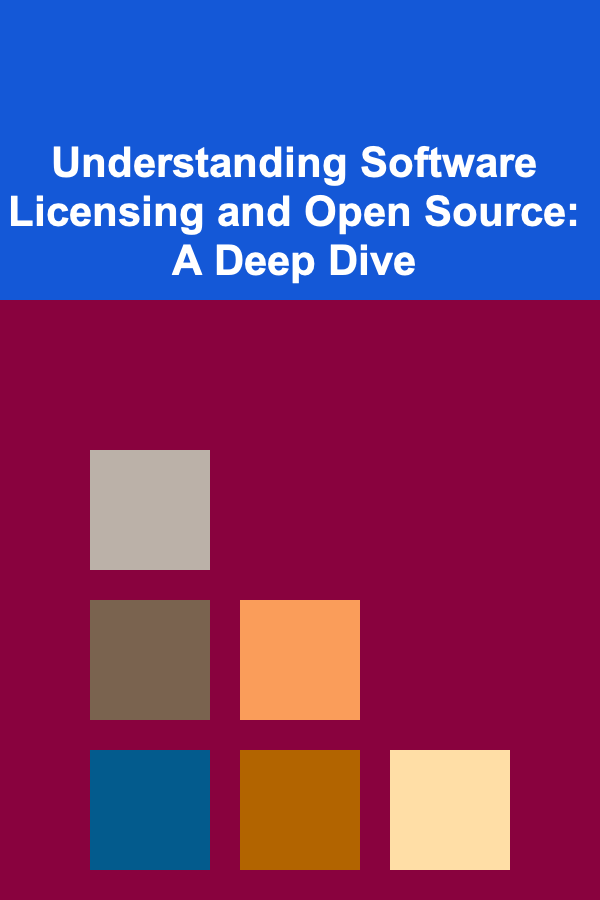
Understanding Software Licensing and Open Source: A Deep Dive
ebook include PDF & Audio bundle (Micro Guide)
$12.99$9.99
Limited Time Offer! Order within the next:

Software licensing and open source are fundamental concepts in the modern software landscape. Understanding them is crucial for developers, users, businesses, and anyone involved in the creation, distribution, or use of software. This article provides a comprehensive exploration of software licensing models, the principles of open source, the various types of open-source licenses, and the implications of each for different stakeholders.
What is Software Licensing?
Software licensing is essentially a legal agreement that grants users the right to use software under specific conditions. It defines the terms and conditions under which a software product can be used, copied, modified, and distributed. Think of it as a rental agreement for software -- you pay for the right to use it, but you don't necessarily own it.
The primary purpose of software licensing is to protect the intellectual property rights of the software developer or copyright holder. It allows them to control how their software is used and prevent unauthorized copying, distribution, or modification. In exchange for granting these rights to users, the licensor often receives compensation, typically in the form of a license fee.
Without a software license, a user technically doesn't have the legal right to use the software. Unauthorized use can lead to legal consequences, including lawsuits for copyright infringement.
Types of Software Licenses
Software licenses come in a wide variety of forms, each with its own set of terms and conditions. Here are some of the most common types:
Proprietary (Commercial) Licenses
Proprietary licenses, also known as commercial licenses, are the most restrictive type of software license. They grant users limited rights to use the software, often prohibiting copying, modification, and redistribution. The source code is typically kept secret and not available to the user.
Examples of proprietary software include Microsoft Windows, Adobe Photoshop, and many enterprise software applications. Users typically pay a fee to obtain a license to use the software. This fee can be a one-time purchase price for a perpetual license or a recurring subscription fee.
Key characteristics of proprietary licenses:
- Source code is not available. Users cannot inspect or modify the underlying code.
- Restrictions on copying and distribution. Users are generally prohibited from making copies of the software or distributing it to others.
- Limited rights of use. The license typically specifies how the software can be used, such as for personal use or for commercial purposes.
- Developer retains all rights. The software developer retains all rights to the software, including the right to modify, distribute, and sell it.
- Often comes with warranties and support (though sometimes limited). The developer may provide warranties and support for the software, but these are often limited in scope.
Shareware Licenses
Shareware licenses allow users to try out the software for a limited period or with limited functionality before paying for a full license. It's essentially a "try before you buy" model.
During the trial period, the software may be fully functional, or it may have certain features disabled or time-limited. After the trial period expires, the user is expected to purchase a license to continue using the software.
Key characteristics of shareware licenses:
- Free trial period. Users can try the software for a limited time without paying.
- Limited functionality or time-limited use. The trial version may have certain features disabled or may expire after a certain period.
- Payment required for full functionality. Users must purchase a license to unlock all features or continue using the software after the trial period.
- Often distributed freely. Shareware is often distributed freely over the internet or through other channels.
Freeware Licenses
Freeware licenses allow users to use the software for free, without any payment required. However, freeware licenses typically still impose restrictions on copying, modification, and distribution. The source code is usually not available.
While freeware is free of charge, it's important to understand that it is still subject to a license agreement. The license may specify how the software can be used, and it may prohibit certain activities, such as commercial use or redistribution.
Key characteristics of freeware licenses:
- Free of charge. Users can use the software without paying.
- Restrictions on copying, modification, and distribution. The license may still impose restrictions on how the software can be used, copied, modified, and distributed.
- Source code is usually not available. Users cannot inspect or modify the underlying code.
- No warranty or support. The developer typically provides no warranty or support for the software.
Open Source Licenses
Open-source licenses grant users the freedom to use, study, modify, and distribute the software. The source code is made available to the public, allowing anyone to inspect and improve it. Open-source licenses are based on the principles of open collaboration and community development.
We will delve deeper into open-source licenses in the next section.
Understanding Open Source
Open source is a philosophy and a software development methodology that emphasizes transparency, collaboration, and community. At its core, open source is about giving users the freedom to control and modify the software they use.
The Open Source Definition
The Open Source Initiative (OSI) is a non-profit organization that promotes and protects open-source software. The OSI has defined the "Open Source Definition" (OSD), which outlines the criteria that a software license must meet to be considered an open-source license. These criteria are designed to ensure that users have the freedom to use, study, modify, and distribute the software.
The ten points of the Open Source Definition are:
- Free Redistribution: The license shall not restrict any party from selling or giving away the software as a component of an aggregate software distribution containing programs from several different sources.
- Source Code: The program must include source code, and must allow distribution in source code as well as compiled form. Where some form of product is not distributed with source code, there must be a well-publicized means of obtaining the source code for no more than a reasonable reproduction cost, preferably downloading via the Internet without charge.
- Derived Works: The license must allow modifications and derived works, and must allow them to be distributed under the same terms as the license of the original software.
- Integrity of The Author's Source Code: The license may restrict source-code from being distributed in modified form only if the license allows the distribution of "patch files" with the source code for the purpose of modifying the program at build time. The license must explicitly permit distribution of software built from modified source code. The license may require derived works to carry a different name or version number from the original software.
- No Discrimination Against Persons or Groups: The license must not discriminate against any person or group of persons.
- No Discrimination Against Fields of Endeavor: The license must not restrict anyone from making use of the program in a specific field of endeavor. For example, it may not restrict the program from being used in a business, or from being used for genetic research.
- Distribution of License: The rights attached to the program must apply to all to whom the program is redistributed without the need for execution of an additional license by those parties.
- License Must Not Be Specific to a Product: The rights attached to the program must not depend on the program's being part of a particular software distribution. If the program is extracted from that distribution and used or distributed within the terms of the program's license, all parties to whom the program is redistributed should have the same rights as those that are granted in conjunction with the original software distribution.
- License Must Not Restrict Other Software: The license must not place restrictions on other software that is distributed along with the licensed software. For example, the license must not insist that all other programs distributed on the same medium must be open-source software.
- License Must Be Technology-Neutral: No provision of the license may be predicated on any individual technology or style of interface.
Benefits of Open Source
Open source offers numerous benefits to developers, users, and businesses alike:
- Transparency: The availability of source code allows anyone to inspect the software and verify its functionality and security.
- Community-driven development: Open-source projects are often developed by a community of contributors, leading to faster innovation and better quality.
- Flexibility and customization: Users can modify the software to meet their specific needs.
- Cost-effectiveness: Open-source software is often free of charge, reducing the cost of software development and deployment.
- Interoperability: Open-source software often adheres to open standards, making it easier to integrate with other systems.
- Security: The open nature of the code allows for greater scrutiny and faster identification and correction of vulnerabilities.
- Innovation: Open source fosters innovation by allowing developers to build upon existing code and share their improvements with the community.
Common Misconceptions about Open Source
There are several common misconceptions about open source that need to be addressed:
- Open source is always free. While many open-source licenses allow free use, modification, and distribution, some licenses may impose restrictions on commercial use or redistribution. Furthermore, while the software itself may be free, support, consulting, and customization services may incur costs.
- Open source is insecure. The opposite is often true. The open nature of the code allows for greater scrutiny and faster identification and correction of vulnerabilities. Many critical security flaws in proprietary software remain hidden for extended periods, while open source vulnerabilities are often quickly addressed by the community.
- Open source is only for hobbyists. Open-source software is widely used in enterprise environments and is the foundation for many critical infrastructure systems. Many large companies contribute to and rely on open-source projects.
- Open source is difficult to use. While some open-source software may require technical expertise, many user-friendly open-source applications are available for everyday use. Furthermore, the large and active communities surrounding many open-source projects provide ample support and documentation.
Types of Open Source Licenses
Not all open-source licenses are created equal. They vary in terms of the restrictions they impose on users and the obligations they place on those who modify and redistribute the software. Understanding the different types of open-source licenses is crucial for choosing the right license for your project or for understanding the implications of using open-source software in your own projects.
Open source licenses can be broadly categorized into two main types: permissive licenses and copyleft licenses.
Permissive Licenses (e.g., MIT, BSD, Apache)
Permissive licenses, also known as "BSD-style" or "MIT-style" licenses, are the most liberal type of open-source license. They impose minimal restrictions on the use, modification, and distribution of the software. You can essentially do whatever you want with the code, including incorporating it into proprietary software.
Common permissive licenses include:
- MIT License: A very simple and widely used license that allows users to use, copy, modify, merge, publish, distribute, sublicense, and/or sell copies of the software, subject to the following condition: "The above copyright notice and this permission notice shall be included in all copies or substantial portions of the Software."
- BSD License (various versions): Similar to the MIT license, the BSD license allows users to use, copy, modify, and distribute the software, even for commercial purposes, as long as the original copyright notice is retained. There are several variants of the BSD license, including the 2-clause BSD license (also known as the Simplified BSD License or FreeBSD License) and the 3-clause BSD license (also known as the New BSD License or Modified BSD License).
- Apache License 2.0: This license allows users to use, modify, and distribute the software, even for commercial purposes. It also includes a patent grant, which protects users from patent infringement lawsuits. The Apache License 2.0 requires that the original copyright notice and a copy of the license be included with the distribution.
Key characteristics of permissive licenses:
- Minimal restrictions: Very few restrictions on how the software can be used, modified, and distributed.
- Commercial use allowed: Can be used in commercial projects, including proprietary software.
- Relicensing allowed: Modified versions can be relicensed under a different license, including a proprietary license.
- Simple and easy to understand: Typically short and straightforward licenses.
- Requires attribution: Typically requires that the original copyright notice be included in the distribution.
Permissive licenses are often preferred by developers who want to encourage wide adoption of their software and minimize the legal burden on users.
Copyleft Licenses (e.g., GPL, LGPL)
Copyleft licenses are designed to ensure that derivative works of the software remain open source. They require that any modifications or extensions to the software be licensed under the same copyleft license. This ensures that the benefits of open source are preserved and extended to future generations of the software.
The most well-known copyleft license is the GNU General Public License (GPL).
- GNU General Public License (GPL): The GPL requires that any derivative works of the software be licensed under the GPL. This means that if you modify GPL-licensed software, you must release your modifications under the GPL as well. The GPL is a "strong" copyleft license, meaning that it applies to the entire work, not just the specific GPL-licensed component. There are different versions of the GPL, including GPLv2 and GPLv3, each with its own nuances.
- GNU Lesser General Public License (LGPL): The LGPL is a more permissive version of the GPL. It allows you to link LGPL-licensed code into proprietary software, as long as you provide a mechanism for users to replace the LGPL-licensed component with a modified version. The LGPL is often used for libraries and components that are intended to be used in both open-source and proprietary projects.
Key characteristics of copyleft licenses:
- Requires derivative works to be open source: Any modifications or extensions to the software must be licensed under the same copyleft license.
- Ensures that the benefits of open source are preserved: Prevents the software from being "closed off" and becoming proprietary.
- Can be complex to understand: Copyleft licenses can be more complex than permissive licenses, requiring careful consideration of the licensing terms.
- May restrict commercial use: The GPL can be restrictive for commercial projects, as it requires that the entire work be licensed under the GPL.
- Promotes collaboration and community: Encourages developers to contribute back to the open-source community.
Copyleft licenses are often preferred by developers who want to ensure that their software remains open source and that the benefits of open source are shared with the community.
Choosing the Right Open Source License
Choosing the right open-source license is an important decision that should be made carefully. The best license for your project will depend on your goals and priorities.
Here are some factors to consider when choosing an open-source license:
- Your goals for the project: Do you want to encourage wide adoption of your software, or do you want to ensure that it remains open source?
- Your tolerance for restrictions: Are you comfortable with imposing restrictions on the use, modification, and distribution of your software?
- The type of software you are developing: Is it a library, a component, or a standalone application?
- The existing licenses of the dependencies you are using: You need to ensure that your license is compatible with the licenses of the dependencies you are using. Some licenses are incompatible, meaning that you cannot combine code licensed under those licenses in the same project.
- Your legal resources: Consult with a lawyer to ensure that you understand the legal implications of the license you choose.
Here's a quick guide to help you choose a license:
- If you want to encourage wide adoption and minimize restrictions, choose a permissive license like MIT or BSD.
- If you want to ensure that your software remains open source and that the benefits of open source are shared with the community, choose a copyleft license like GPL or LGPL.
- If you are developing a library or component that you want to be used in both open-source and proprietary projects, choose LGPL.
- If you are unsure, consult with a lawyer or an open-source licensing expert.
Implications for Different Stakeholders
The choice of software license has significant implications for different stakeholders, including developers, users, and businesses.
Developers
- Control over their code: Licenses dictate how others can use, modify, and distribute their work.
- Protection of intellectual property: Licenses help protect against unauthorized copying and distribution.
- Community building: Open-source licenses can foster collaboration and community contribution.
- Commercial opportunities: Licenses can enable developers to monetize their software through licensing fees, support services, or dual licensing (offering both open-source and commercial versions).
Users
- Rights to use the software: Licenses grant users the legal right to use the software.
- Freedom to modify the software: Open-source licenses allow users to customize the software to meet their needs.
- Access to source code: Open-source licenses provide access to the source code, enabling users to understand how the software works and to fix bugs.
- Cost savings: Open-source software is often free of charge, reducing the cost of software acquisition.
Businesses
- Legal compliance: Businesses need to ensure that they are complying with the terms of the software licenses they use.
- Risk management: Understanding software licenses is crucial for managing the risks associated with using third-party software, including potential copyright infringement lawsuits.
- Competitive advantage: Open-source software can provide a competitive advantage by reducing costs, increasing flexibility, and fostering innovation.
- Strategic use of open source: Businesses can strategically use open-source software to build their own products and services, contribute to open-source projects, and attract and retain talent.
Conclusion
Software licensing and open source are complex but essential concepts. A solid understanding of the various license types, the principles of open source, and the implications for different stakeholders is crucial for anyone involved in the software ecosystem. By carefully considering the options and choosing the right license, developers can protect their intellectual property, users can enjoy greater freedom and control, and businesses can gain a competitive advantage.
Remember to always consult with legal professionals for specific advice regarding software licensing and open source compliance.
Reading More From Our Other Websites
- [Home Rental Property 101] How to Find Houses for Rent with a Wood Burning Fireplace
- [Home Security 101] How to Protect Your Home from Natural Disasters with Security Measures
- [Screen Printing Tip 101] Cost-Effective Techniques to Scale Up Logo Production with Screen Printing
- [Home Family Activity 101] How to Have a Family Cooking Challenge in Your Kitchen
- [Home Cleaning 101] How to Create a Sustainable and Eco-Friendly Cleaning Kit
- [Home Family Activity 101] How to Turn Your Family History Project into a Fun and Educational Quest
- [Home Maintenance 101] How to Clean and Maintain Your Home's Windows for Better Energy Efficiency
- [Home Budget 101] How to Choose Between Debt Snowball and Debt Avalanche for Your Home Budget
- [Home Maintenance 101] How to Prevent Pest Infestations in Your Home
- [Personal Financial Planning 101] How to Financial Planning for Late Starters: Catching Up on Your Financial Goals

Beginner Guide: Understanding Blockchain Technology
Read More
How to Understand the International Space Station
Read More
How to Handle Long-Distance Dating
Read More
How to Build a Stronger Sense of Purpose
Read More
Exploring the Connection Between Trauma and Physical Symptoms: A Comprehensive Guide
Read More
10 Tips for Effective Character Development Rehearsals
Read MoreOther Products

Beginner Guide: Understanding Blockchain Technology
Read More
How to Understand the International Space Station
Read More
How to Handle Long-Distance Dating
Read More
How to Build a Stronger Sense of Purpose
Read More
Exploring the Connection Between Trauma and Physical Symptoms: A Comprehensive Guide
Read More